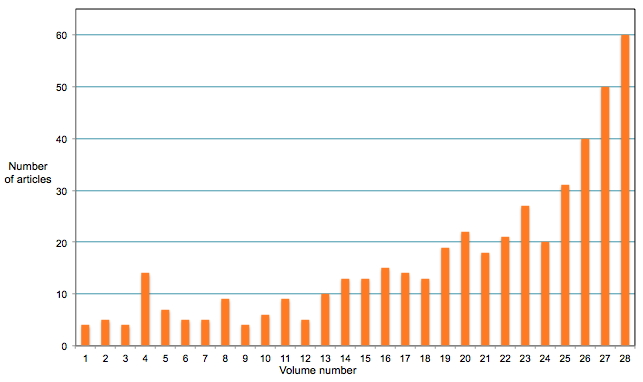
 |
Editorial 29(1): Revisiting some IIER statistics
Figures 1-3 are updates for figures presented in IIER Editorial 25(4): Surfing the waves of change in IIER's first 25 years. An update was promised in Editorial 28(3): Reflecting upon the numbers for 2018, and although the updates here add only 3 volumes to the 25 previously presented, it's worthwhile that we do so, to draw renewed attention to three important trends, and the main questions arising:

Figure 1: Number of articles in IIER, vol 1 (1991) to vol 28 (2018)
(the counts are for research articles only; editorials and book reviews excluded)

Figure 2: Numbers of articles in IIER, vol 1 (1991) to vol 28 (2018), by country of origin
(country of origin is determined by the institutional affiliation of
the article's first author, at the time the research was conducted)

Figure 3: Gender of authors of articles in IIER, vol 1 (1991) to vol 28 (2018)
(count is all authors, except 10 (1.1%) for whom gender was not ascertainable by
simple searches; authors with two articles are counted twice, etc.)
Secondly, the aggregate "Rest of world" does not show the problem of uneven representation of some regions or countries. For example, some countries in the Middle East region are well-represented in IIER (e.g. Turkey and Iran), whilst some countries in the Asiatic region are under-represented (e.g. Indonesia and India). This is also a "work in progress, as time permits", in which we intend to follow the region classification scheme used by Scimago (Scimago Journal & Country Rank, 2019). The Scimago classification distinguishes eight regions comprising Pacific (Australia, New Zealand, Fiji, Papua New Guinea and others), Africa, Asiatic, Eastern Europe, Latin America, Middle East, Northern America, and Western Europe.
Thirdly, there are likely to be interesting inter-country and inter-region differences in the representation of women authors. Some countries and regions have attained or surpassed the longer term estimate of "52-57% women" given in 3. above, whilst others are somewhat behind trend. This issue is yet another "work in progress, as time permits".
Readers who are interested in bibliometrics for IIER, at both journal level and article level, may be reassured that IIER's approach endeavours to be based firmly upon the ten principles outlined in Hicks, Wouters, Waltman, de Rijcke and Rafols (2015).
Roger Atkinson, Clare McBeath and Anne Power
Co-editors IIER 29(1), 2019
Atkinson, R., McBeath, C. & Power, A. (2018). Editorial 28(3): Reflecting upon the numbers for 2018. Issues in Educational Research, 28(3), ii-iii. http://www.iier.org.au/iier28/editorial28-3.html
Atkinson, R. (2013). Journals with borders, journals without borders: Under-representation of Asian countries in educational research journals. Higher Education Research & Development, 32(3), 507-510. http://dx.doi.org/10.1080/07294360.2013.790528
Hicks, D., Wouters, P., Waltman, L., de Rijcke, S. & Rafols, I. (2015). The Leiden Manifesto for research metrics. Nature, 520 (7548, 23 April), 429-431. https://www.nature.com/polopoly_fs/1.17351!/menu/main/topColumns/topLeftColumn/pdf/520429a.pdf
IIER bibliometrics. http://www.iier.org.au/about/iier-bibliometrics.html
Scimago Journal & Country Rank (2019). Country rankings. Social sciences. Viewed 17 January 2019. https://www.scimagojr.com/countryrank.php?area=3300
| Please cite as: Atkinson, R., McBeath, C. & Power, A. (2019). Editorial 29(1): Revisiting some IIER statistics. Issues in Educational Research, 29(1), ii-v. http://www.iier.org.au/iier29/editorial29-1.html |